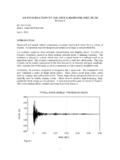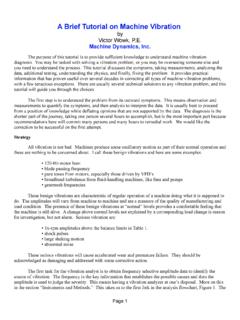Transcription of GUIDELINES ON STABILITY TESTING OF COSMETIC PRODUCTS
1 GUIDELINES ON STABILITY TESTING OF COSMETIC PRODUCTSM arch 2004 All rights reserved to CTFA and Colipa 1 GUIDELINES ON STABILITY TESTING OF COSMETIC PRODUCTS March 2004 I. GENERAL CONSIDERATIONS 1. INTRODUCTION General The purpose of STABILITY TESTING COSMETIC PRODUCTS is to ensure that a new or modified product meets the intended physical, chemical and microbiological quality standards as well as functionality and aesthetics when stored under appropriate conditions. Because the development cycle of COSMETIC PRODUCTS is relatively short, and also, in order that the TESTING activity does not become economically disproportionate in view of the multitude of product launches each year, each manufacturer must have at their disposal tests that are adapted to their activity.
2 Each manufacturer should design their STABILITY TESTING program such that it is reasonable and efficiently addresses the TESTING required. This document aims to set out GUIDELINES in order to predict and assure the STABILITY of PRODUCTS in the market place. Its purpose is to aid manufacturers of COSMETIC PRODUCTS in the selection and the refinement of the appropriate STABILITY tests. Although this guideline can provide a helpful starting point, it is important that manufacturers carefully evaluate new PRODUCTS and technologies and, where appropriate, adapt their TESTING to reflect differences between product types and formulations.
3 However, all methods assuring the final STABILITY of a COSMETIC product against the categories cited in paragraph below, if it is at least equivalent to the recommendations of the following chapters, are considered as valid. Procedures must be put in place and documented within the manufacturer s internal system. 2 General STABILITY of a COSMETIC Product Whether conducted in real time or under accelerated conditions, tests should be done in order to assure: STABILITY and physical integrity of COSMETIC PRODUCTS under appropriate conditions of storage, transport and use, Chemical STABILITY , Microbiological STABILITY , The compatibility between the contents and the container.
4 Moreover, concerning methodology, the manufacturer should, for each formula type, select the pertinent criteria according to their experience and evaluate these at one or more temperatures. The evolution of the test parameters should then be judged by the corresponding expert and a decision made for each criterion on the basis of the company s internal procedures and experience. An evaluation, based on all of the criteria should then allow for the predicted or real STABILITY of the product to be deduced. Because of the wide variety of COSMETIC PRODUCTS and their inherent complexity, standard STABILITY tests cannot be prescribed.
5 Manufacturers, who have an intimate knowledge of their PRODUCTS and packages, require the flexibility to modify TESTING protocols and to build a sound scientific basis for assessing product STABILITY . Thus, specific tests may be developed in order to predict possible evolutions of the product, to address new/unusual technologies, or to be adapted to PRODUCTS having extended shelf lives. Accelerated STABILITY Tests Accelerated tests, developed because of the relatively short development cycle for COSMETIC PRODUCTS , enable the prediction of STABILITY .
6 A commonly accepted practice is to support the forecasts obtained from accelerated STABILITY TESTING by carrying out periodic post-launch monitoring of retained samples stored at ambient temperatures. The resultant information can also be useful in further improving the product and in refining the methodology used for accelerated STABILITY TESTING . 2. DESIGNING A COSMETIC STABILITY STUDY A STABILITY study should include the following considerations (each of which will be discussed in more detail later): Identify tests that will accelerate and predict the effects of normal conditions of storage and use.
7 Where relevant, consider stresses, including temperature, that will enable assessment of product integrity under anticipated product exposure conditions. Consider evaluation of critical aesthetic properties such as color, fragrance, texture, and flow, particularly after exposure to conditions designed to stress each specific property. Consider variation in process conditions. 3 Consider the impact of packaging on the contained product, as well as any effects which the product might have on the packaging.
8 3. PREDICTING SHELF LIFE There is very little generally-applicable published research to support specific accelerated methods for predicting COSMETIC shelf life. Some of the reasons for this lack of information are: The variety and complexity of COSMETIC formulas and packaging. The proprietary nature of many PRODUCTS and STABILITY test methods. The variety of types of changes that need to be examined, including physical, chemical, microbial, functional or aesthetic changes. Accelerated Conditions Accelerated test conditions are internationally recognized as appropriately predicting product shelf life in many industries.
9 Appropriate conditions, for example with regard to temperature and/or duration, should be chosen according to the product category and the in-house know-how and should be based on sound scientific judgment. Data acquired using various techniques at different temperatures and durations can be used, possibly in conjunction with the use of mathematical models, to predict STABILITY . Tests are often performed at 37 C, 40 C or 45 C during 1, 2, months but the temperature used and the duration will depend on the product type. For instance, for certain product categories other temperatures may prove to be more useful.
10 Based on the accelerated STABILITY results and on its scientific experience, a company may then be able to predict the actual STABILITY for given market conditions. Scale-Up STABILITY TESTING In the early stages of product development, initial determinations of product STABILITY can be made by TESTING samples from laboratory batches under appropriate conditions. As development progresses, it may be necessary to make more precise determinations of probable STABILITY by TESTING samples from batches manufactured with equipment representative of that which will be used to manufacture the commercial product.









